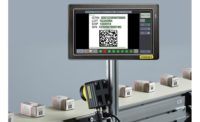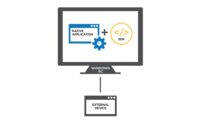Imagine a future without machine downtime, zero inefficiencies, and more affordable products. That future is becoming a reality faster than you think. The Industrial Internet of Things (IIoT), sometimes also referred to as Industry 4.0, is making this future a reality while simultaneously disrupting conventional wisdom about manufacturing. Take for example Zero Downtime Technology (ZDT), developed in a joint effort between FANUC and General Motors. ZDT monitors the health and stability of robots continuously, worldwide for GM. Globally, more than 50 unscheduled downtime events have been prevented by ZDT already, avoiding an average downtime of six to eight hours each and preventing thousands of lost production units. GM uses approximately 30,000 robots in its facilities across the globe, and about 8,000 of them are now part of ZDT—with that number increasing quickly!
How would this look on a grander scale? To visualize where we are going we need to understand how we got here. In the late 18th century, Industry 1.0 used steam power to run mechanical production. It wasn’t until the early 20th century that the emergence of electrical power helped us evolve into Industry 2.0 with mass production. The next evolution happened in the 1970s, when electronics and IT infrastructure began automating production and led to what we’ve known up through today as Industry 3.0. Our next step as a civilization is IIoT and Industry 4.0, where cyber-physical systems will monitor, analyze, and improve our manufacturing operations.
The National Science Foundation describes a cyber-physical system as “deeply integrated physical and digital components, each operating on different spatial and temporal scales, exhibiting multiple and distinct behavioral modalities, and interacting with each other in a myriad of ways that change with context.” In other words: smart factories. The machines in smart factories will use self-optimization, self-configuration, and artificial intelligence to complete complex tasks in order to deliver vastly superior cost efficiencies and better quality goods and services.
The success of cyber-physical systems like ZDT, the cornerstones of tomorrow’s smart factories, will be dependent on their ability to capture, process, and analyze never-before-seen levels of sensory data regarding their environment. This is where machine vision takes center stage.
Machine Vision in IIoT
For decades, machine vision technology has demonstrated its ability to inspect, measure, scan, or otherwise identify a variety of products throughout a broad spectrum of applications. Due to increasing affordability of machine vision components and systems, a broader array of solutions, more capable hardware, and smarter AI-based software algorithms, machine vision is positioned well for substantial growth within the IIoT movement. The main catalyst, however, to its potential growth in IIoT applications will be connectivity. Once connected to each other and ultimately the cloud, machine vision systems become unique extraction tools that can draw insight from images and display it for entire factories or value chains.
Cameras are getting smaller and more affordable, which is leading to higher adoption rates in IIoT projects. We find our AIA member companies are focusing on robotics, 3D imaging, and machine learning, along with growing emphasis on software to power artificial intelligence (AI) and artificial neural networks (ANN). In addition to visible imaging solutions, the non-visible imaging side, including multispectral and infrared is also expanding. Asset monitoring in factories where cameras transmit live images and diagnostic data to mobile user platforms is one example.
The machine vision industry is also experiencing a convergence with embedded (or computer) vision. As more low-cost, board level embedded image processors become available for industrial environments, it is likely that we will begin to see the emergence of new types of integrated automation solutions. For example, a robot arm with several embedded imagers.
With all of this developing technology, it is imperative that the machine vision industry offers reliable, repeatable, and evolving standardized interfaces for its products. In today’s market, the top machine vision interfaces include: Camera Link, Camera Link HS, CoaXPress, GigE Vision, and USB3 Vision. GenICam (Generic Interface for Cameras) provides a generic programming interface for all kinds of cameras, no matter what hardware interface technology is used or what features are implemented. These interface standards are important for continued, widespread adoption of machine vision cameras in IIoT applications because they offer customers a variety of value propositions and suppliers based on their needs.
Unique Challenges
The entire purpose of the Industrial Internet of Things is the ability to monitor, analyze, and (most importantly) control your operation from anywhere on the globe. This makes factors like bandwidth and latency very important to its success. While Moore’s Law has led to an impressive increase in the amount of information that can be transmitted seamlessly in today’s world, high-resolution images still require hardware, software, and communications interfaces that are on-par for the task. Applications that require this type of infrastructure can be resource intensive and costly to implement.
As we connect more devices to the internet, cyber security becomes more important. Consider for a moment a smart factory where every camera, robot, and machine is connected to the cloud. Now imagine hundreds of those same factories worldwide. The amount of potential entry points for hackers has increased exponentially in this scenario, placing a premium on the company’s ability to silo, monitor, predict, and ultimately react to security breaches. It should come as no surprise that research firms like Markets and Markets have found that the cyber security market is estimated to grow to $170 billion (USD) by 2020, at a compound annual growth rate (CAGR) of 9.8 percent from 2017 to 2020.
Plenty of Opportunities
Opportunities to build smart factories are plentiful. According to the SCM World Internet of Things Manufacturing Survey conducted in 2015, 63% of manufacturing executives believe that smart manufacturing and its underlying technology is ready now or will be within five years. There is a need for this in the marketplace and a desire to evolve.
The IIoT movement is arriving at a good time. In the United States alone, the average age of industrial equipment is the highest it’s been since 1938, four in ten manufacturers have little to no visibility into the status of their operations, 50% of manufacturers become aware of a problem only after a breakdown occurs, and less than five percent of revenue is spent on investments in capital equipment. The market is ready to explode.
The U.S. is not alone here. According to Accenture, IIoT is expected to add almost $15 trillion to the world economy over the next 15 years. In concert, the worldwide robotics industry is expected to grow by north of 10% annually over the next five years, and markets like the U.S., China, and Mexico are key areas of increasing automation investment. Enabling technologies like machine vision, motors, and motion controllers are also expected to be in high demand as manufacturers look to fully outfit their smart factories.
Having to sit in front of your PC in order to evaluate the health of your business will also become a thing of the past. By 2019, the market for industrial mobile applications is expected to quadruple to $200 million, according to IHS. Industrial mobile applications include phone/tablet functionality for control and visualization, workflow management, maintenance, and system integration. Plant managers will be able to monitor images from their machine vision systems on their smart phones wherever they are, and more quickly respond to issues that arise based on notifications from apps and software connected to those systems.
A Positive Impact on Employment
The Industrial Internet of Things brings tremendous opportunities for companies to increase productivity, meet consumer demands for innovative, high-quality products, and drive the advancement of new industries. As companies grow and successfully compete through the use of automation technologies, they thrive and form the foundation for vibrant communities that boast a strong tax base, good schools, and a wide range of supporting industries.
But skilled workers are key to companies’ success. For years, employers have ranked talent—defined as the quality and availability of highly skilled workers who facilitate a shift towards innovation and advanced manufacturing strategies—as the most critical driver of global competitiveness, according to the Global Manufacturing Competitiveness Index. As new jobs arise, new approaches to education and training are also coming into play, offering attractive and viable options for new entries to the workforce as well as career-changers and underserved members, such as returning veterans, and raising diversity opportunities across industries. Our Association for Advancing Automation (A3) members, partners, and colleagues are working hard to put programs in place across industries to develop and support this talent base and help bridge the skills gap. As with Industries 1.0 through 3.0, Industry 4.0 (IIoT) and the automation age offer challenges, but also incredible opportunities.
Conclusion
We are in the midst of ushering in a new era of industrial production. We’ve begun to see the benefits of the new IIoT manifested in solutions like Zero Downtime Technology by FANUC and General Motors—and new applications like this are cropping up each day. This Industrial Internet of Things will bring a new level of visibility, efficiency, and productivity to factories across the globe. Cyber-physical systems will be the main enablers of new smart factories, and machine vision will play a central role in delivering valuable data to decision makers. As we move further into this new era, premiums will be placed on communications technology, advanced software algorithms, and cyber-security. Meanwhile our workforce will adapt and grow. Educational programs designed for automation, on-the-job apprenticeships, and new jobs we can’t even envision yet will lead us to a more productive, prosperous tomorrow.














